Montreal Protocol Phases Out Hydrofluorocarbons
Acommon type of chemical used in air conditioning and refrigerants will be phased out in the next two years, as the United States and nearly 200 nations have agreed to amend the Montreal Protocol. The amendment gradually eliminates the production and use of heat-trapping chemicals known as hydrofluorocarbons (HFCs).
The phase-down schedule begins in 2019 for developed countries. Eliminating the use of hydrofluorocarbons will cut 80 billion metric tons of carbon dioxide equivalent emissions by 2050, avoiding warming of up to 32.9 degrees F. by the end of the century.
“From the climate agreement forged in Paris to this new accord reached in Rwanda, the international community is continuing a year of positive action to cut the heat-trapping emissions that are warming our planet," says U.S. Secretary of Energy Ernest Moniz. “These agreements will send signals to industry and innovators that countries are committed to developing and deploying a new generation of energy efficient and low-carbon solutions.”
HFCs are potent greenhouse gases that are exponentially more harmful to the environment than carbon dioxide. They make up a small fraction of the total of all greenhouse gases, but their emissions are estimated to increase twentyfold in the decades to come.
